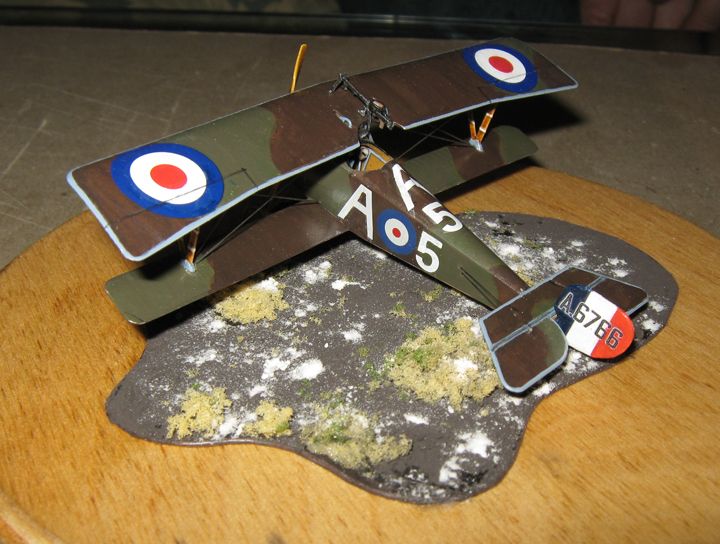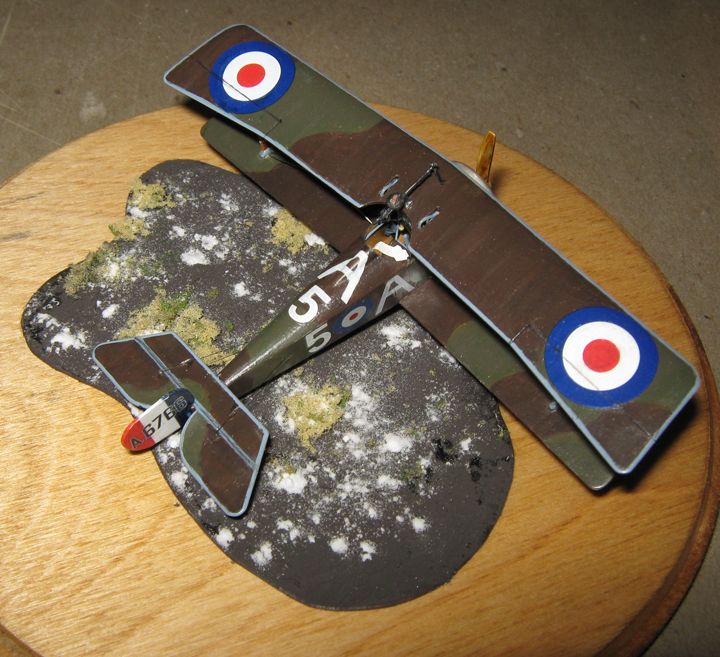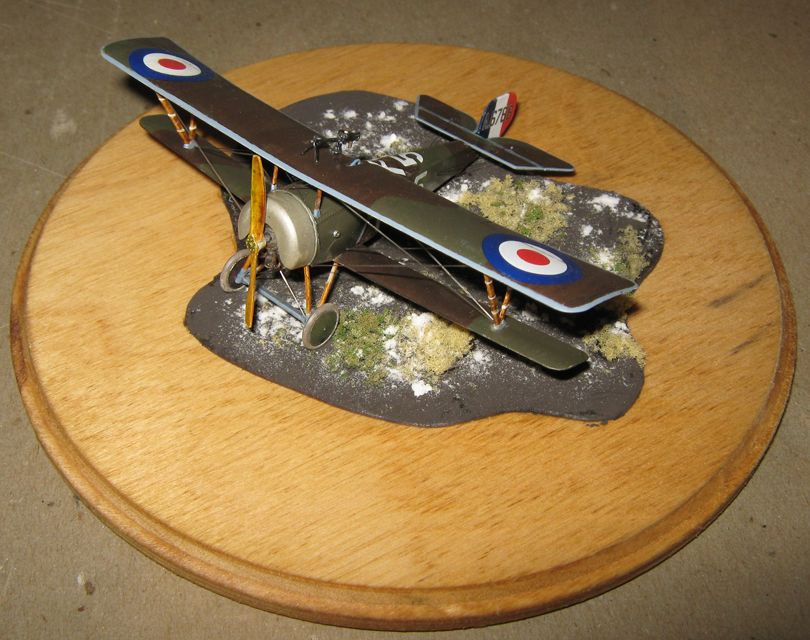
The 'Nieuport Scout' was the predominant single-seat machine of the Royal Flying Corps during April of 1917, a period which has passed into Great War aviation lore as 'Bloody April'. 60 Squadron, with an establishment of 18 pilots, suffered 23 casualties that month, the great preponderance of them killed over the German rear areas. This was not unusual, but rather typical of the toll taken on RFC units participating in the Battle of Arras. It is from the RFC in this period that the commonly cited factoid 'the life expectancy of a fighter pilot on the Western Front was three weeks' stems, along with the classic movie cliche of the repeated waves of eager replacements straight from basic the C.O. mournfully commits to a first mission he knows they will never return from. And in that month in the RFC these things were true enough; after the initial losses, casualties were disproportionately new arrivals, and many who arrived as replacements during 'Bloody April' never saw the coming May.
When first introduced, in the form of the 80hp N.11 'bebe', the sesquiplane single-seat Nieuport was a superb fighting machine, clearly superior to anything else operating in the skies over France. The type reached its apogee in mid-1916 with the introduction of the larger 'fifteen meter' design (so called from the square area of its wings), powered by a 110 hp motor. The most usual 'fifteen meter' type was the N.17, but there were also the N.21, with an 80 hp motor, and the N.23, which employed a different synchronizer for a Vickers gun than that used on the N.17, but was otherwise almost identical. By autumn of 1916, however, the French were already beginning to replace the type with the SPAD VII, and the appearance that autumn of the German Albatros fighter, with its good speed and heavy armament, left the Nieuport sesquiplanes at a disadvantage.

The 'Nieuport Scout' remained, however, about the best single-seat machine available in reliable quantity to the Royal Flying Corps as 1917 began. England's aviation industry had been very small when the Great War began, and its expansion during 1916 had been achieved by concentration on existing, standardized designs. New fighting types certainly were appearing as the year began, but in small number, and machines the French were finding surplus to their own requirements had to remain a great portion of RFC single-seat strength. When received by the RFC, these 'fifteen meter' machines had their synchronized Vickers removed, and replaced with the earlier armament of a Lewis gun on the upper wing, firing over the propeller. Primitive in appearance, and introducing difficulties of aim, this arrangement did give a superior rate of fire, and broke about even on reliability, as the exposed gun was susceptible to cold, while the synchronized gun, though warmed on the cowling, was prey to a variety of malfunctions in the intricate linkages governing its fire.
Over the Battle of Arras in April, 1917, the obsolescence of English equipment collided with operational necessities and tactical doctrines, and the result was something of a mangle. The battle itself was conceived as an assistance to the great push planned by the French, the 'Neville Offensive' at Chemin des Dames, projected to be the blow that would collapse the German front and end the war in speedy victory at last. RFC commander Gen. Trenchard's conviction his men should always take the fight to the enemy over his rear areas sent aircrew in large numbers into circumstances of great disadvantage, in generally poor equipment, in order to meet the needs of the ground battle for reconnaissance and direction of artillery fire. At heavy cost, the RFC did what was required by the men on the ground --- and as it turned out, even this was hideously futile, because when the 'Neville Offensive' went in in late April, it collapsed in a bloody welter that set the French Army to mutiny, which continued throughout the summer.

This particular 'Nieuport Scout' of 60 Sqdn, A6766, was an N.23 'fifteen meter' type. This differed from the N.17 at production in that its synchronizing gear required the Vickers gun to be off-set a little to the right, rather than being on the center-line, which in turn required a small alteration in the arrangement of cabane flight wires, so the one to the starboard longeron would clear the gun. When taken over by the RFC, as A6766 was in mid-March, 1917, replacement of the Vickers with an over-wing Lewis rendered the machine indistinguishable from a standard N.17, although it received, in common with many RFC 'Nieuport Scouts', a new pattern windscreen, very different from the French factory fitted one. A6766 went to 60 Sqdn on 26 March, 1917, where it was assigned to 2nd Lt. Charles Sidney Hall, of 'A' Flight.

Lieutenant Hall then was a young man. eighteen going on nineteen. He was born in Ashington, Northumberland, in 1898, to a fairly prosperous family. He was an athletic youth, coming to hold an honorary instructor's certificate and medallion from the Royal Lifesaving Society, and resolved on a career as a mining engineer, towards which he took up studies at Armstrong College of the University of Dunham. With two older brothers in service, the eldest a Captain in the R.F.C. assigned as a flight instructor, and the other with the Royal Engineers, Charles signed on to the O.T.C. at his college, and enlisted after he turned eighteen, while the Battle of the Somme was in full spate. He followed the course of his eldest brother, going directly into the Royal Flying Corps. By early 1917 he was a trained pilot, and posted to France. The date of his arrival at 60 Sqdn is not recorded, but 60 Sqdn had had a pair of pilots killed or injured in March, 1917, after a long spell of inactivity owing to poor flying weather, and Lt. Hall may well have been assigned there as replacement for one of these men. In any case, the young man made a good impression for himself, and proved popular both with his fellow officers and the ground crew of the unit.
On the morning of April 2nd, 1917, 60 Sqdn was given a 'special' assignment, for which one Nieuport was fitted with a camera to take photographs of particular value. 'A' Flight had the camera Nieuport, and Lt. Hall piloted one of the three escorts accompanied it when the mission took off at 7:15 in the morning from Filescamp Farm aerodrome. At a quarter to eight, they ran into Albatros Scouts from Jasta 2, over Fontaine-les-Croisilles. In the melee, Lt. Hall engaged one Albatros closely, and sent it spinning down out of the fight, for which he was awarded an OOC (out of control) victory credit. It was something, at least, to balance the death of an 'A' flight pilot down in flames in that fight.
Late in the afternoon of April 7, Lt Hall was again one of the escorts on a 'special' camera mission, taking off from Filescamp Farm at 16:40. An hour later, the flight was on its way back when they were attacked at 17:45 over Mercatel by four Albatros Scouts of Rtmtr. von Richtofen's Jasta 11. Under attack, 'A' flight pilots found their Lewis guns sporadically inoperative due to freezing. Lt. Hall was one of two 60 Sqdn pilots shot down and killed in this fight, which went on for some time, and only ended when the melee fetched up to the English lines. Survivors reported one Albatros spinning down from the fight, but none claimed it, and this was awarded to Lt. Hall and Lt. Smart, the other pilot killed, as a shared OOC victory credit.

The model is an Eduard N.17 (in 1/72) built without much incident (it is a very good kit), with a scratch-built windscreen, and home-made markings. The tactical markings are pieced together from white decal strip and white dry-transfer 'L' and 'O' letters; the rudder markings are home-print decals wife was kind enough to lay out for me (she is quite the witch at that sort of thing). A photograph of A6766 (with Lt. Hall standing beside it) appearing in Mr. Revell's recent 60 Squadron history establishes the machine was in camouflage finish with white letters, not aluminum dope with black markings, and I have employed the usual French green and brown of 1916, as the date is too early for the five-color treatment, and refinishing in P.C.10 is highly unlikely. The photograph shows no white surround on the fuselage roundel, which I have taken to indicate its absence on the upper wing as well. The build began on a whim; I simply wanted to do a camouflaged Nieuport Scout, and found the photograph directly at hand. I became curious, though, about the pilot named as flying it, and as I found out more, the young fellow emerged as a character, and came to seem to me a fair type for the experience of the Royal Flying Corps in 'Bloody April'.

I would like to thank the gentlemen over at 'The Great War Forum', who provided me with a great deal of information on Lt. Hall, and also Mr. Revell for answering several questions, and Mr. Russ Gannon, for looking into details of the two air fights Lt. Hall is recorded as participating in.
[/quote]